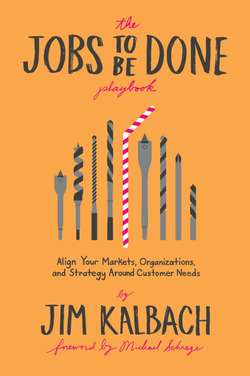Читать книгу The Jobs To Be Done Playbook - Jim Kalbach - Страница 30
На сайте Литреса книга снята с продажи.
Hierarchy in JTBD
ОглавлениеThe parable goes like this: A traveler came upon three stoneworkers arranging bricks and asked them what they were doing. The first replied, “I’m laying bricks.” The second answered, “I’m building a room.” When the traveler got to the third man, he heard a different response. “I’m building a cathedral,” the stoneworker replied. Of course, all three answered correctly; it’s just a matter of perspective.
When working with JTBD, you’ll confront the issue of granularity. The question you need to answer is, “At what level of abstraction do you want to try to innovate?” There’s no right or wrong answer—it depends on your situation and aim. Getting the right altitude is key. Objectives at one level roll up into higher-order goals, generally called laddering.
In JTBD work, the principle of laddering applies as well. For instance, in his book Competing Against Luck, Clayton Christensen points to “big jobs,” or things that have a big impact on our lives (like finding a new career) and “little jobs,” or things that arise in our daily lives (such as passing time while waiting in line).
Rather than just two levels—big and little—I have found that JTBD can be viewed on about four different levels (see Figure 2.6).
• Aspirations: An ideal change of state, something the individual desires to become
• Big Job: A broader objective, typically at the level of a main job
• Little Job: A smaller, more practical job that corresponds roughly to stages in a big job
• Micro-Job: Activities that resemble tasks but are stated in terms of JTBD
FIGURE 2.6 Recognize the different levels of abstraction in JTBD.
For example, I once experienced a mismatch in goal levels while interacting with Zipcar, the popular carsharing service. On one occasion, I showed up to my reserved car spot, and the vehicle wasn’t there. After immediately calling customer service, they offered to pay for a cab ride to my destination. Job done.
But on Mother’s Day another year, the same thing happened: I arrived to my reserved car, and it wasn’t there. This time, rather than offering an alternative ride option, the Zipcar agent proceeded to name other locations to pick up a Zipcar. All of them would have added hours to my trip.
In other words, while I was trying to get to my family’s house at a specific time (a big job), in this case, the agent was trying to rent me another car (a little job). Consider some of the different levels of abstraction in this example, reflected in Table 2.5.
TABLE 2.5 LEVELS OF JOBS TO CONSIDER
| LEVEL | EXAMPLE |
| Aspiration | Be a better family member |
| Big Job | Visit with family on special occasions |
| Little Job | Arrange transportation at a specific time |
| Micro-Job | Start vehicle |
There are many stages of the main job, visit with your family, including planning, scheduling, arranging, traveling, arriving, visiting, and departing, for instance. Each of these smaller jobs can be broken down further. Arranging transportation has the steps of deciding, reserving, confirming, and initiating, for example. Typically, the main job is broad to be more inclusive, but it can also be broken down into subsequent parts.
Note that the aspirations are technically not jobs. There are many ways to be a better family member, and there is no real “done” state. But oftentimes, your team may ladder up in defining the main job, gravitating toward overarching motivations. Having the category “aspirations” lets you capture a high-level thought, but then move down to the appropriate level of discussion.
For instance, if you find yourself defining the main job as be a better professional or enjoy the arts or even be satisfied in life, you probably need to move down a level in the hierarchy. Make a note of a relevant aspiration—it will help frame how a solution gets designed and marketed. But scoping your initial innovation effort at the aspirational level can yield an endless number of possible directions. It’s more effective to target a big job and layer aspirations secondarily on top of that.
To reiterate, JTBD provides a sequence for innovation: start with the job performer and the main job defined at an appropriate functional level. Create solutions that get that job done first. Then consider aspects like emotions and aspirations for framing how the solution gets implemented and delivered to a market.
